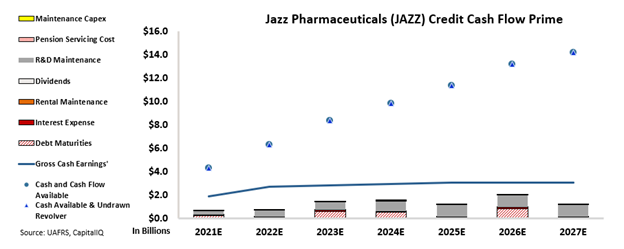Pharmaceuticals are difficult stocks to invest in, but today’s company’s credit profile tells a simple story

Here at Valens, we are cautious about recommending pharma and biotech equity investments because of the advanced industry knowledge required to succeed.
That said, when it comes to credit investing, the fundamental principles are largely the same. Today’s pharmaceutical company is massively misunderstood by the rating agencies.
Also below, the company’s Uniform Accounting Performance and Valuation Tearsheet.
Investor Essentials Daily:
Wednesday Credit Insights
Powered by Valens Research
When analyzing investment opportunities for clients, we are largely industry agnostic, with one major caveat.
We do not generally make explicit investment recommendations on pharmaceutical and biotechnology companies. While we can use Uniform Accounting to understand the companies’ historical profitability, making estimates and predictions about future pipelines requires a competency we do not have.
Many hedge funds will employ former doctors, chemists, and biologists when they want to invest in pharma and biotech.
To really invest in the equities of these types of businesses, analysts must have a deep scientific understanding of the companies’ current patents and future drug pipelines.
This is a highly specialized space, so even though we can provide the right financial data, we recommend our clients make their own judgements on drug pipelines.
However, this logic only applies to the equity side of the pharma and biotech industries.
From a credit perspective, these industries can be treated like any other, especially when it comes to legacy and long-lasting pharmaceutical companies. Jazz Pharmaceuticals (JAZZ) is a great example.
As we mentioned above, our specialty includes providing cleaned up financial data.
For the major rating agencies, this is not always the case. S&P, for example, incorrectly gives Jazz a non-investment grade speculative BB- rating, with the implied assumption of a 10%+ risk of default over the next five years.
Despite Jazz Pharmaceuticals being a stable, long-standing player in the pharmaceutical industry, rating agencies like S&P consider the firm a moderate bankruptcy risk.
Our Credit Cash Flow Prime (CCFP) analysis is able to get to the heart of the firm’s true credit risk.
In the below chart, the stacked bars represent the firm’s obligations each year for the next five years. These obligations are then compared to the firm’s cash flow (blue line) as well as the cash on hand at the beginning of each period (blue dots) and available cash and undrawn revolver (blue triangles).
As depicted, Jazz Pharmaceuticals has massive cash liquidity and therefore should have no issues handling its obligations going forward. On top of this, even if the firm did not have access to this capital, cash flows alone exceed all obligations by a wide margin every year including 2023, 2024, and 2026, when the firm has debt maturities.
Rather than a name in distress, Jazz Pharmaceuticals is actually a cash flow machine. This is why S&P’s BB- non-investment grade speculative rating, with a 10%+ risk of default expectation does not make sense.
Using the CCFP analysis, Valens rates Jazz Pharmaceuticals as an investment grade IG3+ rating. This rating corresponds with a default rate below 1% within the next five years, a more realistic projection once a holistic understanding of the company’s risk is taken into account.
SUMMARY and Jazz Pharmaceuticals plc Tearsheet
As the Uniform Accounting tearsheet for Jazz Pharmaceuticals plc (JAZZ:USA) highlights, the Uniform P/E trades at 8.9x, which is below the global corporate average of 23.7x, but around its historical average of 7.8x.
Low P/Es require low EPS growth to sustain them. That said, in the case of Jazz Pharmaceuticals, the company has recently shown a 17% Uniform EPS growth.
Wall Street analysts provide stock and valuation recommendations that in general provide very poor guidance or insight. However, Wall Street analysts’ near-term earnings forecasts tend to have relevant information.
We take Wall Street forecasts for GAAP earnings and convert them to Uniform earnings forecasts. When we do this, Jazz Pharmaceuticals’ Wall Street analyst-driven forecast is 21% EPS decline in 2021, then a 49% growth in 2022.
Based on the current stock market valuations, we can use earnings growth valuation metrics to back into the required growth rate to justify Jazz Pharmaceuticals’ $181.08 stock price. These are often referred to as market embedded expectations.
The company is currently being valued as if Uniform earnings were to shrink by 17% annually over the next three years. What Wall Street analysts expect for Jazz Pharmaceuticals’ earnings growth is above what the current stock market valuation requires in 2021 and below in 2022.
Furthermore, the company’s earning power is 6x the corporate average. Also, cash flows and cash on hand are 5x above its total obligations—including debt maturities, and capex maintenance. However, intrinsic credit risk is 100bps above the risk-free rate. Together, this signals a moderate credit risk.
To conclude, Jazz Pharmaceuticals’ Uniform earnings growth is above its peer averages and the company is trading below average peer valuations.
Best regards,
Joel Litman & Rob Spivey
Chief Investment Strategist &
Director of Research
at Valens Research





